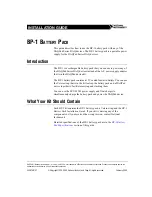
4
11
15.GB
2
Charging electronics
The SLT 100 charging electronics monitor
and control the charging operation.
Progress of the charging operation is
shown by the light-emitting diodes (7).
An electronic monitoring unit detects the
gassing time and determines the optimum
recharging time from the charged capacity
(Ah balancing).
Charging starts automatically with a time
delay (approx. 10 sec. to protect the plug
contacts) after the battery has been
connected to the charger.
The control key (12) can be used to cancel
operation at any time.
The standby (13), charging (7), charging
completed (9),
and
compensation
charge (8) conditions are indicated by the
LEDs (13,7,9,8).
An automatic safety cut-out is provided,
when the gassing voltage has not been
reached within an initial charging phase of
12 hours.
Z
The automatic safety cutout is displayed by
the yellow warning display LED
(11)
(flashing code): 3x / interval / 3x.
If the transformer overheats, a warning
is indicated (11) (flashing code: 4x /
interval / 4x). As soon as the transformer
temperature is in the permissible range
again, charging will be continued and the
LED goes off.
Optimum battery charging requires
adaptation to the mains supply. The
charging electronics are zero-voltage proof,
i.e. no malfunctions are possible as a result
of mains failures, as all times are stored
and charging will recommence at the point
the failure had occurred.
3
Protection / Ambient conditions
Protection: IP 22
Ambient conditions:
The charger is self-cooled and is designed
for a max. ambient temperature of
40 °C and a max. relative humidity of 80 %.
Minimum ambient temperatures:
- for storage
-20 °C
- for operation
0 °C
If the charger thaws due to sudden
temperature changes, leave the charger for
a least 3 hours before switching it on again.
M
The charger must only be stored in
enclosed areas. Operation of the battery
charger is only permitted in spaces
specially provided for this purpose.
4
Identification label,
e.g. E230 G24/50 SLT 100
(see “Sample Data Plate” on page 18)
Z
The identification label is located on the
rear wall of the unit.
13
12 11
10
9
8
7
D = 3-phase curr
E = Alternating curr
Mains voltage (V)
Charging rectifier
Initial charging voltage (V)
Initial charging current (A)
Battery load
E 230 G 24 / 50 B SLT 100
13
11
15.GB
G
Internal electrolyte stirrer (EUW)
1
Correct use and application
Z
See also Chapter A ,“Correct use and
application”.
The battery charging device with a built-in
pump and hose system is suitable only for
batteries with electrolyte stirring.
User obligations:
The user must make sure that only
batteries with electrolyte stirring or with a
hose system are permitted to be charged.
M
The pump must not be operated without
counterpressure.
2
Charger Assembly
F
The battery charger must not be operated
outdoors.
Choose the assembly location so that:
- There is sufficient ventilation.
- The flow of cooling air through the
charger is not restricted. It must not be
installed close to radiators or similar heat
sources.
- No flammable gases or dust mixtures
can penetrate inside the charger.
- The charger is placed only on a solid and
secure surface. The surface must not
consist of flammable material.
- The bottom of the charger is approx.
0.5 m above the battery to be charged.
F
It is forbidden to store food in the vicinity of
battery chargers.
Z
The VDE 0510 safety regulations must be
observed.
3
Electrolyte circulation (EUW)
During charging the electrolyte circulation
pump is switched on for approx. 2.5 min.
and off for approx. 7 min.
Charging is recognised by the charge
switch insofar as it:
- Detects the connected battery.
- Detects a charge current.
During the pulse charge phase there is no
electrolyte circulation. The pump is
switched off.
4
Description of the device
During the main charging phase, batteries
without electrolyte circulation generate acid
layers. The charging factor is set according
to the charging device.
Internal electrolyte circulation:
Internal electrolyte stirring is automatically
switched on at the beginning of the
charging procedure. Electrolyte stirring
mixes the acid before the gassing phase.
Z
In the main charging phase, the battery’s
energy consumption increases so that the
recharging phase can be shortened.
The internal charging electronics detect via
the sensor that the pump is switched on
and reduce the recharging time. This
shortens the total charging time at the same
battery charge level.
Содержание SLT 100
Страница 1: ...SLT 100 SLT 100 Operating instructions 50451882 SLT 100 G 10 04 11 15...
Страница 4: ...I2 0709 GB...
Страница 23: ......
Страница 24: ......








































